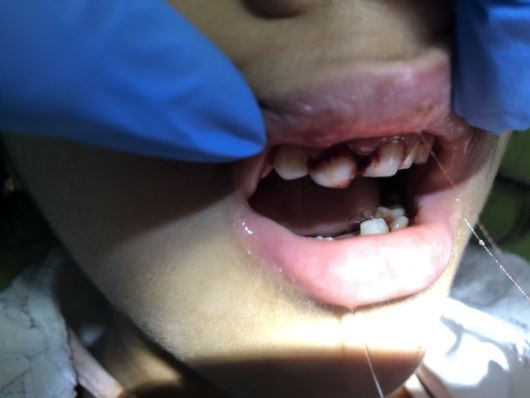Case Discussion: Dental Trauma

Credits: Dr. Tamara
Case Description: Five year old girl came with her parents to the morning clinic crying hysterically after she fell in the bathroom while dressing up to go to school causing dental trauma.

Credits: Dr. Tamara
Introduction: Nearly 50 percent of children will have some type of injury to a tooth during childhood, many of which are preventable. Mouth injuries are also common. Tooth and mouth injuries often occur after a fall, motor vehicle accident, sports injury, or fight.
This topic based on our case will provide useful information to parents about dental trauma injuries, some important tips and points to be considered to handle such situations.
Parents often wonder if a child’s permanent or primary teeth were injured. Permanent teeth are not usually present before six to seven years of age. Primary teeth look different than permanent teeth. The actual treatment of dental injuries depends upon the type of injury and whether the injured tooth is a primary (baby) or permanent (adult) tooth. In any case, there are few common steps that always remain standard for all such situations. Below, a quick insight is provided for parents on what to do in case of an injured primary or permanent tooth.
If a baby, toddler, or young child injures the gums or baby teeth:
- Apply pressure to the area (if it’s bleeding) with a piece of cold, wet piece of gauze.
- If your child is old enough to follow directions, ask him or her to bite down on the gauze.
- Offer an ice pop to suck on to reduce swelling, or hold an ice-pack wrapped in a washcloth to the cheek.
- Give acetaminophen or ibuprofen as needed for pain.
- Call a dentist.
- Watch for swelling of the gums, continued pain, a fever, or a change in the color of the tooth.
If a permanent tooth is chipped or broken:
- Collect all pieces of the tooth.
- Rinse the mouth with warm water.
- Call a dentist right away to schedule a visit.
- Management according to diagnosis and age of the child
| 1 | Hold the tooth by the crown (the white part of the tooth) and avoid touching the root (the yellow part). |
| 2 | If the tooth is clean, try to put it back. |
| 3 | If the tooth is dirty, don’t wash it. |
| 4 | Put the tooth in milk, contact lenses solution or under the child’s tongue. |
| 5 | Don’t wrap it in cotton or tissue. |
| 6 | Visit dental facility ASAP. |
Prevention Methods:
Mouthguards can significantly reduce the risk of mouth injuries and the incidence of jaw fracture in children involved in sports. Also educating the children in order to avoid such situations can be useful.
Useful Links:
https://www.sickkids.ca/pdfs/Dentistry/12902-DentalInjuries.pdf
https://www.mittenkids.com/what-to-do-for-your-childs-traumatic-dental-injury/


